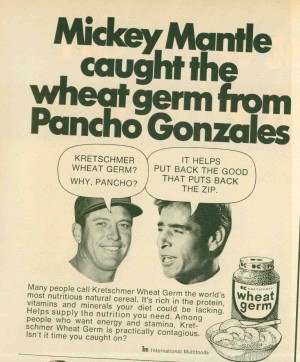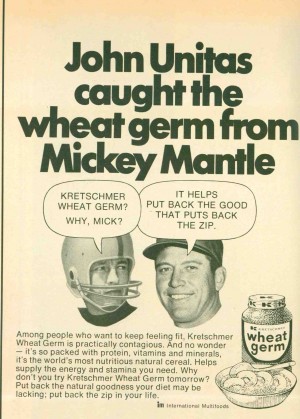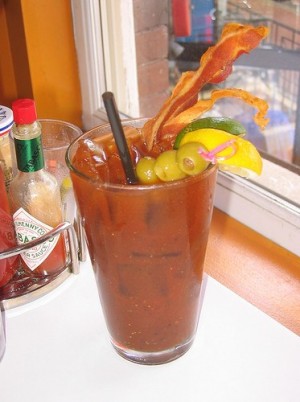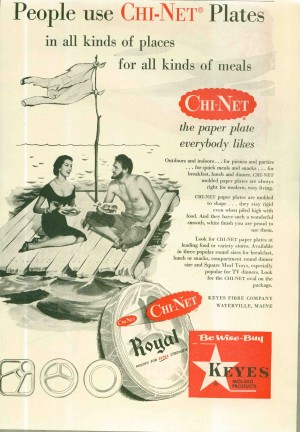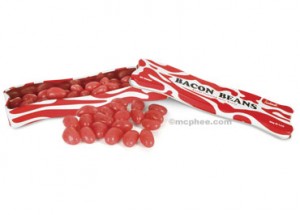Food
Preparation of Foods
If our readers plan on cooking animal testicles, they'll need to know all about the history of food prep, including that new discovery--microwaves!
Posted By: Paul - Thu Oct 02, 2008 -
Comments (0)
Category: Food, Documentaries, 1960s, Yesterday’s Tomorrows
Follies of the Mad Men #32
[From Life magazine for April 23 1971.]
Okay, here's today's lesson, ad guys, and I'll only tell you once:
YOU NEVER COMPARE YOUR PRODUCT TO A PLAGUE OR STD, EVEN IN JEST!!!
Posted By: Paul - Wed Oct 01, 2008 -
Comments (7)
Category: Business, Advertising, Products, Celebrities, Food, Sports, 1970s
Breakfast by Svankmajer
Thanks to High Weirdo Sandy Pearlman, we can all enjoy this little gem by filmmaker Jan Svankmajer.
Posted By: Paul - Mon Sep 29, 2008 -
Comments (3)
Category: Art, Surrealism, Body Modifications, Food, Movies, Foreign Customs
Pig Farms
Still on the bacon thread!Sure, we all love bacon! But who wants to live next to a pig farm? Not these folks in Massachusetts, who, according to today's Boston Globe (registration required), suffer smells like those "at the bottom of a dumpster." But this new Congressional report finds the EPA ready to relax their rules for such farms.
Here's an article about a manure lagoon spill in 2005 that released 3 million gallons of pig poop!
Posted By: Paul - Wed Sep 24, 2008 -
Comments (12)
Category: Agriculture, Animals, Bathrooms, Disasters, Food, Scatology, Lawsuits, Excrement
Bacon Bloody Marys
After Baconhenge and Bacon Beans, what other odd bacon bits could there be?Well, what about Bacon Bloody Marys?
For some reason I am reminded of Lisa Simpson asking Bart to please stop stirring his lemonade with a sausage.
Posted By: Paul - Tue Sep 23, 2008 -
Comments (13)
Category: Animals, Fads, Food, Inebriation and Intoxicants
David Lynch Coffee
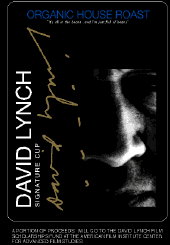 If you love David Lynch's films, you might also love his coffee which you can buy at his website. The Independent reports:
If you love David Lynch's films, you might also love his coffee which you can buy at his website. The Independent reports:The other items for purchase at his site make a bit more sense to me: t-shirts, posters, DVDs, and a Distorted Nudes Book.
Posted By: Alex - Tue Sep 16, 2008 -
Comments (2)
Category: Food
Smoke on the Water

I should have known it would be. I had already read this news about how weekends attract bad weather.
WEEKEND WEATHER REALLY IS WORSE
The most comprehensive weather study ever has confirmed what we all suspected - the weather really is worse at weekends.
Meteorologists at the University of Karlsruhe evaluated 6.3 million pieces of climate data from across Europe between 1991 and 2005.
Their conclusion: On weekends the weather is worse than on weekdays.

Q: Why does the smoke from a campfire seem to blow into your face no matter where you sit or how many times you change position around the fire?
A: Your body blocks the flow of fresh air drawn to the flames. You are then creating a low air pressure area with your body and the warm smoke moves toward the lowest air pressure. With no wind, no matter where you sit in relation to the fire, the smoke will be drawn toward you.
Sometimes you just can't win....
Posted By: Paul - Sun Sep 14, 2008 -
Comments (3)
Category: Entertainment, Family, Food, Science, Weather
Follies of the Mad Men #26
[From Ladies' Home Journal for June 1957.]You just know that the contents of those plates are the raw remnants of their fellow castaways.
Posted By: Paul - Fri Sep 12, 2008 -
Comments (4)
Category: Boats, Business, Advertising, Products, Food, 1950s
Follies of the Mad Men #25

Let's watch A TOUCH OF MAGIC.
Posted By: Paul - Mon Sep 08, 2008 -
Comments (8)
Category: Business, Advertising, Products, Domestic, Marriage, Family, Husbands, Wives, Food, Futurism, History, Inventions, Movies, Pop Culture, Technology, Sex Symbols, 1960s, Dance, Cars, Yesterday’s Tomorrows
Bacon Beans
A week or so ago, Alex told us how to make our own Baconhenge. But perhaps that's not enough bacon for you. In that case, why not nosh on some Bacon Beans as a snack?
Posted By: Paul - Sat Sep 06, 2008 -
Comments (3)
Category: Animals, Food

| Who We Are |
|---|
| Alex Boese Alex is the creator and curator of the Museum of Hoaxes. He's also the author of various weird, non-fiction, science-themed books such as Elephants on Acid and Psychedelic Apes. Paul Di Filippo Paul has been paid to put weird ideas into fictional form for over thirty years, in his career as a noted science fiction writer. He has recently begun blogging on many curious topics with three fellow writers at The Inferior 4+1. Contact Us |

